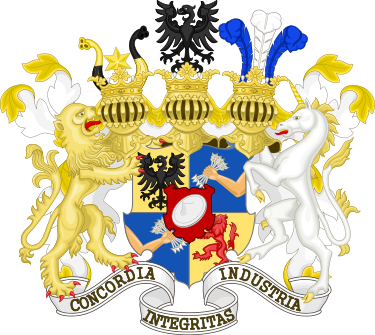The affluent Rothschild family which is based in Europe, is of German Jewish origin. They established banking and finance institutions starting from the late 18th century.
MAYER STARTED IT ALL
It was started by Mayer Amschel Rothschild who is considered the Founding Father of International Finance.
The Rothschild family as a whole today is valued at a total of a combined $1 trillion dollars. They are the most prosperous and wealthiest family in the world at present.
FRANKFURT AS THE FIRST BASE
The Rothschild family were descended from a prosperous Ashkenazi Jewish family which originally came from Frankfurt. Mayer who was appointed a court factor to the German Landgraves of Hesse-Kassel, started the family banking business in the Free City of Frankfurt of the Holy Roman Empire in the 1760s.
Rothschild, as a name, is derived from the German zum rothen Schild which means With the Red Sign. This is in relation to the houses where their family members were living in. In Yiddish, Rothschild means Red Coat (heraldic coat of arms).
Mayer grew up in the Judengasse section of Frankfurt. It is a narrow road where the 3,000 Jewish residents were forced to live in crowded conditions.
At that time, Jewish people couldn’t leave their homes when it is dark, on Sundays and on Christian holidays. They couldn’t go to coffee shops or public gardens. When they are in public, they couldn’t walk together if they were more than 2 people.
Mayer was educated in business at a very early age from Amschel Moses, his father, who was a silk cloth dealer and who also exchanged currency.
Mayer first worked by sorting coins which were acquired in Frankfurt’s trade fairs (which were held twice a year) which lured buyers and sellers from other regions.
The parents of Mayer passed away from smallpox when he was 12. He was sent off to live with relatives in Hannover to do apprenticeship through Simon Wolf Oppenheimer, a well known Jewish banking house.
In his stint here, Mayer learned that rare coins from places such as Persia, the Byzantine Empire and ancient Rome was big business. The collectors were royalty and other rich people and the Jewish gentlemen who negotiated with these important folks were known as court factors or court Jews. This means they transacted business with the nobility.
With this knowledge, Mayer went back to Frankfurt at the age of 19 in 1763 to join his male siblings in the trading business. He became a rare coins dealer and got the trust of Crown Prince Wilhelm of Hesse.
CROWN PRINCE LINKAGE WAS THE KEY FOR MAYER TO GROW EXPONENTIALLY

The Crown Prince was a heir to huge wealth and he was asked by Mayer to make him a crown agent or a court factor.
This honorary title then made it possible for Mayer to have connections with other nobles and permitted Mayer to display from his residence a shield connoting the Hesse and Hanau coat of arms that made public this fact.
In 1770, Mayer got married to Gutle Schanpper who gave him 10 children – 5 sons and 5 daughters.
MAYER’S SONS FUELED THE GROWTH
The Rothschild business grew in size under Mayer’s 5 sons – Nathan Mayer, Salomon Mayer, James Mayer, Amschel Mayer and Carl Mayer. They established branches in Paris, London, Naples and Vienna together with the original which is Frankfurt.
Each son managed the bank branches in each of the 5 international locations. They effectively became the first banking institution to transcend national borders.
They lent to governments for financing war operations over the following centuries which allowed the family to accumulate bonds and built more wealth through other industries.
Thereafter, the Rothschild family have ventured into energy, mining, real estate and wine production. Starting the early 19th century, the family has been known for its philanthropic activities, specifically in arts and education.
The banking business which the Rothschild family started in was further specialized by the descendants into merchant banking, asset management, private banking, insurance, mergers and acquisitions, pensions, venture capital, commodities and sovereign debt.
The Rothschild family also ventured into huge infrastructure undertakings such as railways, tunnels, bridges and the most notable, which is the Suez Canal.
They also entered the hotel, transportation, media and wine businesses.
INHERITANCE ONLY THROUGH MALE LINEAGE
Before Mayer Rothschild passed away, he left instructions that property and title could only be achieved through the male lineage and female descendants can’t have any direct hand in the inheritance.
This is because he desired to keep intact the wealth within the family. This effected encouragement of intermarriages among the members of the family.
From 1824 up to 1877, 36 marriages among the male descendants of Mayer were consummated. 30 of these marriages were along family lines and most married first and second cousins. Only 4 women and 2 Rothschild men married spouses that were not of kin.
NATHAN ROTHSCHILD
Of all the sons of Mayer Amschel Rothschild, it was the third son Nathan, who achieved the most success.
Nathan transferred to Manchester, England in 1798 to put a garment business into motion. He then made another move to London to engage in banking by putting up N M Rothschild in 1810.
Today, the said company is still very much in operation. The bank reported in 2019 1.87 billion pounds in income and 76 billion euros in assets.
THE 20TH CENTURY ROTHSCHILDS
Politics, wars and rivalries within the family have diminished the family wealth going into the next century.
In 1863, the Naples branch closed down and the Frankfurt branch also shuttered in 1901 due to no male heir was available. In 1938, the Vienna branch ceased operations because the Nazis invaded Austria and it was dangerous for Jews to do business.
The Vichy government of France confiscated properties of the Rothschilds in Bordeaux during the war. The Nazis grabbed Rothschild art and other valuable property running into millions of dollar in value in Austria. A portion of it was returned to the family in 1998.
Massive estates of the Rothschilds were given to the French and British governments throughout the years. Donations were also made to various universities and organizations.
When the 1970s arrived, 3 Rothschild banks remained. They were Paris and London banks and a Swiss Bank started through Edmond Adolphe De Rothschild.
In 1982, President Francois Mitterand through his socialist government, nationalized the Paris branch.
But in 1987, Edmond and Baron David Rene James De Rothschild initiated the Rothschild & Cie Banque in Paris.
By the year 2003, French and British banks were unified with David as the chairman.
THE 21ST CENTURY ROTHSCHILDS
In 2008, all Rothschild holdings were unified through a single organization which is one of the shareholders of Paris Orleans based in France. This move reconciled the family business, nearly 2 centuries after the 5 sons of Mayer spread out the businesses across Europe.
Going into the 21st century, the Rothschild riches has been divided among heirs and descendants. Today, Rothschild interests encompass financial services, mining, energy, real estate and philanthropy. In addition, the Rothschild family owns several wine properties throughout the world.
Closely managed corporations are still the status quo of present Rothschild businesses and they continue to reap success. Most of the family members work for the conglomerate or invest in operations that propel the family wealth.
2,003




